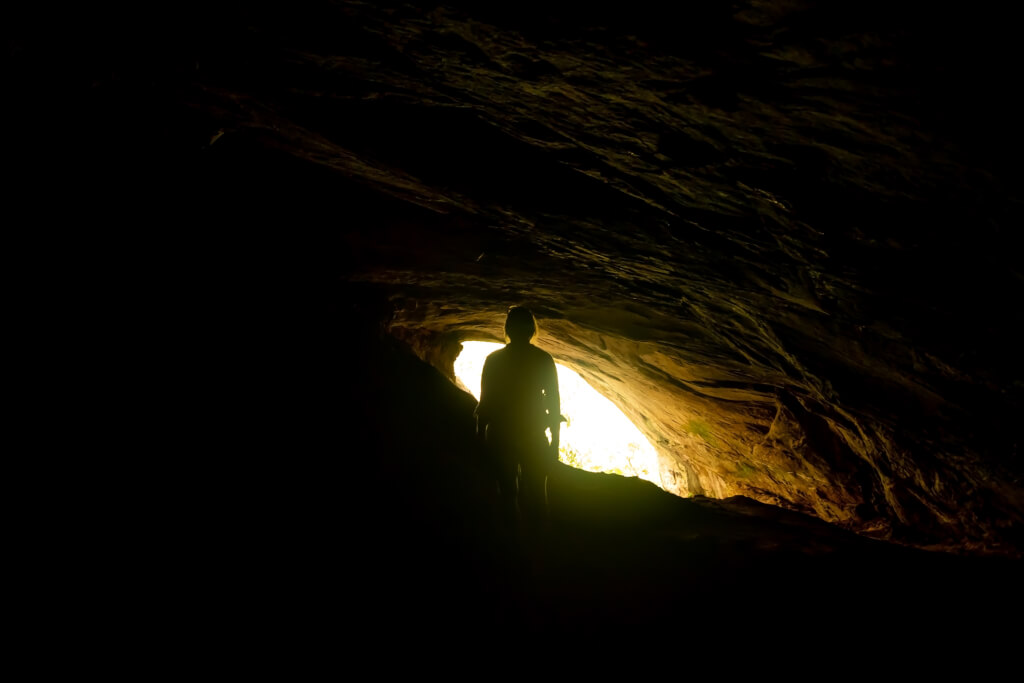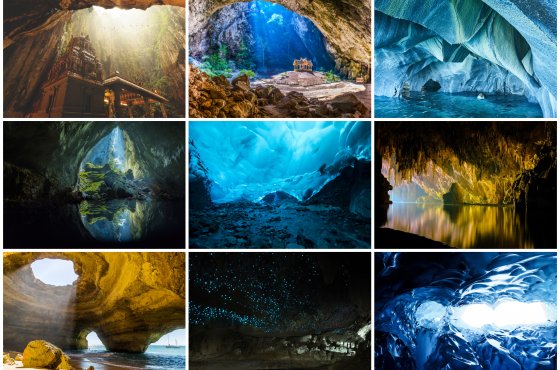A woman lived for 500 days in a cave in complete isolation: it affected her body worse than she expected
Spaniard Beatrice Flamini always sought solitude. After the outbreak of the coronavirus pandemic, she decided to spend 500 days in a cave in complete isolation - in order to set a record and mentally prepare for a long journey through the Gobi Desert, reports Meduza.

Photo: IStock
During the experiment, Beatrice was observed by speleologists and other scientists, but she herself had no contact with the outside world. Flamini left the cave in April 2023 without breaking the record, but enthusiastically describing her impressions to journalists. However, psychologists who observed the experiment suspect that the Spanish woman developed post-traumatic disorder, and her experience of isolation was very far from positive.
500 days without contact with the outside world before trekking in the desert
Beatriz Flamini was born in Madrid in 1973 and since childhood she loved to spend time alone. In the early 1990s, she decided to train as a sports instructor and at the same time (though not alone, but with a friend) for the first time visited the Reguerillo cave, located near Madrid and famous for its Paleolithic paintings. Beatrice said she immediately fell in love with the cave and the sense of calm she experienced there.
On the subject: Boy who went missing in Britain six years ago has been found in France
After graduating from university, Flamini began teaching aerobics in Madrid. By the age of 40, Beatrice had achieved a lot in life: she had a long and strong relationship, a house, a car. But she did not feel satisfied. It seemed to her that she was not doing what she really wanted.
“You realize that you will die someday,” Flamini explained to reporters. - Today, tomorrow, in 50 years. What do you want to do in life before this happens?”
The Spaniard decided to go to the mountains and settled on the Sierra de Gredos ridge in central Spain, getting a job as a caretaker in a nature reserve. After receiving certifications to work at heights and taking first aid courses, she became a mountain rescuer and enjoyed hiking and rock climbing in her free time.
One day Flamini saved a man who was covered by an avalanche. Another time I saw a tourist die from a lightning strike. She spent most of her time alone and even stopped communicating with relatives. However, at that time she had not yet completely broken off contacts with the outside world: for example, she continued to conduct Instagram account.
In 2020, when the coronavirus pandemic began, Flamini settled in an abandoned monastery in the Catalan mountains. In solitude, she walked a lot, occasionally talked on the phone with a friend and learned from her how the situation with coronavirus was in Madrid and the world.
With the end of the lockdown, Flamini decided not to interrupt her self-isolation, but to go to an even more deserted place - the Gobi Desert in Mongolia. After several months of training, she felt that she was ready for the trip physically, but not mentally. Flamini had never been alone for more than 95 days, and crossing the Gobi would certainly have taken longer.
Beatrice began to look for information about people who lived in caves for a long time.
In 1970, the record was set by the Serbian Milutin Veljkovic, who was in the cave for 463 days. However, neither he nor anyone else spent this time completely alone. For example, Veljkovic from time to time called up residents of the nearest village and learned about what was happening in the world on the radio. Flamini decided not only to break his record, but also to do it in complete isolation. She was confident in her abilities, as she had participated in speleological expeditions many times. The Spanish woman set herself a goal - to live 500 days in a cave without contact with the outside world.
Cameras and complete isolation
Members of a caving club from the municipality of Granada suggested Beatriz a suitable cave - north of the city of Motril on the Andalusian coast. Humidity and temperature made it possible to live in it all year round, and the entrance was located next to a cliff more than 60 meters high: random tourists could not disturb the Spanish flu. The main part of the cave was a gallery approximately 30 meters long and nine meters wide, with a height of about 12 meters. It was dark and damp inside, and the floor was covered in stone shards.
Flamini's original plan was to bring enough food and water into the cave to last 500 days, not have any interaction with people, and return to the outside world to go straight to Mongolia.
However, speleologists convinced her that it would be extremely difficult to deliver such a volume of food to the chosen location. Another difficulty was that without outside help she would not be able to dispose of the waste without leaving the cave. Flamini agreed with the cavers that they would leave supplies on the ledge above the cave, and she would climb the cable and take what they brought. One of the Spanish catering companies volunteered to provide Beatrice with canned food for the duration of the expedition.
In addition, she agreed that two security cameras, a panic button and a computer be installed in the cave, through which a one-way signal could be sent if necessary. In order for communications to work, Wi-Fi had to be installed in the cave, but Beatrice did not take any devices with her to communicate with other people - this was still her main condition. Moreover, in order to achieve “complete separation,” she decided not to look at her own face in the mirror for 500 days.
Researchers from the universities of Granada and Almeria agreed to monitor Flamini's isolation. They were going to evaluate changes in her psychological state and circadian rhythms in conditions of isolation and constant darkness. Before releasing the Spanish flu into the cave, scientists conducted several tests. Neuropsychologist Maria Dolores Roldan-Tapia from the University of Almeria concluded that Beatriz is “an extremely determined, motivated and disciplined person.”
Flamini also met with sports psychologist Deborah Godoy Izquierdo, who advised her to speak out her thoughts so as not to lose touch with reality. The Spanish company Dokumalia, which specializes in filming programs about survival in the wild, provided Beatrice with two GoPro cameras so that she could keep a diary. The source of electricity in the cave was solar panels; volunteers left them in the same place as the supplies. They provided enough energy to power two night lights and a Wi-Fi router.
In mid-November 2021, Flamini published a post on Instagram: “On Saturday, November 20, the boat sets off on a new voyage. We will be in touch again in April or May 2023.”
When it was time to go down, Beatrice and the volunteers gathered outside - this was her last interaction with people for the rest of the experiment. She squeezed into the cave with difficulty, stuck out her tongue to those remaining outside and joked: “See you tomorrow.”
Sense of time and hallucinations
At the beginning of the experiment, Flamini kept a diary on her computer and sent notes to scientists, but soon stopped doing this. She tried to keep track of the days, but lost track by the middle of the second month. Before the descent, Beatrice promised observers that she would perform cognitive exercises, but two weeks later she complained that the computer was not working: it turned out that she could not remember the password and entered the wrong ones.
The researchers asked Flamini to use the computer as they had agreed, but she ignored them.
GoPro camera footage shows that in the early days, Beatrice maintained order in the cooking and eating areas, as well as the tent, exercise area and computer station. She arranged them at a distance from each other so that she could move regularly.
One day, Flamini brought a branch into the cave and colored it with markers - in her words, to “preserve a sense of color.” And another time I sat for a long time and looked in front of me, later explaining to the camera that this was training my eyesight.
But soon Flamini’s mood noticeably worsened. After the experiment, she admitted that after the first few months she stopped remembering the details of what was happening, and spent 95% of her time sitting or lying in the dark in a state of “hibernation.” In one of the GoPro recordings, Beatrice explained how difficult it is not to know the time of day, adding that it is “always four in the morning” for her.
The longer Flamini lived alone, the more strange she behaved. For example, at some point she stood in front of the camera cradling a thermos, and then sharply turned to the wall and exclaimed, addressing the cave: “How beautiful you are! You are wonderful and friendly! You are kind, and there are a lot of crickets living inside you. I think it's crickets. You are simply charming!” When she went to bed, Flamini, she said, sometimes heard drumming in her head and imagined that a certain shaman was sending her a welcoming signal.
“I’m sure if I last 30 days everything will be perfect,” Beatrice said in one of the recordings. Then she believed that she lived in the cave for 19 days, but in fact she was there almost twice as long.
Another time, Beatrice decided that autumn had come outside and she needed to collect all the stones from the bottom of the cave: it seemed to her that this was the body’s way of saying that it was time to harvest. But in reality at that moment it was only the beginning of summer. Flamini tried to keep track of time using her menstrual cycle, but it became too irregular.
In January 2022, Beatrice said she was hearing something strange. In another GoPro recording, she asked volunteers to give her a voice recorder and insisted that she had no paranoia or hallucinations. Trying to find a rational explanation for what was happening, she assumed that a large animal had fallen into the cave and decided to sleep with a knife in the tent.
Soon she stopped keeping order: camera footage shows that blankets, books, clothes, pots and pans were scattered throughout the camp. Then Beatrice began to be afraid of the dark. The gaps between entries in her video diary became longer and longer. When they did appear, it was clear that she was not nearly as determined as at the beginning of the experiment. At some point, it seemed to Flamini that the floor in the cave was moving. The sounds that had initially fascinated her began to irritate her.
About six months into the experiment, Flamini realized that trying to keep track of time was only making her more anxious.
“In a cave, the linear movement of time stops, and everything just floats around you,” she explained after the experiment. — Some time ago I was born. Some time ago I was planning to go to Mongolia. There is no future or past. Everything is happening in the present or has already happened some time ago. It's difficult and strange."
The only confirmation that time was passing was the waste disposal schedule, which Flamini took out in a bag every five trips to the toilet to the place where volunteers picked it up and left fresh food for her.
In April 2022, Beatrice complained of pain and numbness in her legs. At that time, she spent most of her time in a tent and slept a lot.
Sometimes she drew comics about her adventure and in one of them she even depicted volunteers - however, in these drawings the people did not have faces. Flamini also knitted woolen hats for friends, and during the entire experiment she read about 60 books (later she admitted that she didn’t remember almost any of them). In addition, Beatrice began communicating with GoPro as if she were interacting with real people. She hugged the cameras and even flirted with them, imitated the bats living in the cave and said that she had a new hairstyle.
One day Beatrice thought she was dying. According to her, she was relieved.
“There was no difference between what I felt then and how I imagine death,” Flamini admitted after the end of the experiment.
In September 2022, when the experiment had been going on for almost 300 days, Flamini had to violate its main condition due to interference coming from the router. From them, Beatrice began to have headaches and nosebleeds. Then she took out the tent and set it up in front of the entrance to the cave. Six days later, David Reyes, the head of the speleological team that was monitoring her condition, came to her. Flamini explained to him that she could not be in the same room as the router. Volunteers called specialists to replace the equipment. And Beatrice returned to the cave and resumed the experiment.
After this, Flamini snapped at the speleologists several times. She once recorded a ten-minute tirade accusing volunteers of changing a knot on a rope she was climbing along to get supplies without warning. She later admitted that she tied the knot herself, but forgot about it.
Despite the deterioration of her mental state, the Spaniard almost achieved her goal and spent 492 days in the cave (for eight days her tent stood outside due to problems with the router). Beatriz later recalled that when Reyes followed her into the cave, she lay and “drifted,” but his voice brought her out of her stupor.
Experts suspect the woman has developed PTSD
Almost immediately after leaving the cave, Flamini held a press conference. The Spaniard behaved in front of journalists better than could have been expected, given almost a year and a half of isolation - she joked and smiled. When asked if she ever wanted to terminate the experiment early, Beatrice answered in the negative and added that she already missed the cave. Scientists who followed the experiment suggested that this behavior at the press conference could be a defense mechanism and a reaction to trauma. Having said goodbye to the journalists, Flamini almost immediately lost consciousness. She was taken to the hospital, but, according to the Spaniard herself, all indicators were normal. However, she did not remember how she behaved at the press conference.
Many researchers and professional cavers have expressed doubt that Flamini had, as she claims, an "amazing" and "unique" time in the cave. According to her stories, the experiment seemed almost like a vacation.
“Everyone thought I would come out of there as a zombie, but they were wrong!” — she joked and assured that she didn’t even manage to miss anyone in 500 days.
Later, in a conversation with The New Yorker correspondent D.T. Max, the Spaniard admitted that after the experiment she began to be frightened by sounds whose source she did not see. If something happens behind or to the side of her, she becomes uncomfortable: in a dark cave, she is used to looking only in front of her - in the direction where the light of the headlamp fell. She said she wouldn't advise other people to repeat her experience on themselves because "darkness sucks the life out" and "loneliness consumes you."
You may be interested in: top New York news, stories of our immigrants, and helpful tips about life in the Big Apple - read all this on ForumDaily New Y
While Flamini willingly spoke with The New Yorker, she flatly refused to conduct further research that the scientists who had been watching her throughout the experiment wanted to conduct. She explained that her experience was unique and she had to process it in her own way. Scientists have suggested that she is still not ready to seriously discuss her stay in the cave and analyze her experiences.
“All her behavior indicates the presence of PTSD (post-traumatic stress disorder), says neuropsychologist Maria Dolores Roldan-Tapia. “Survival in the cave traumatized her, even though it was voluntary. Based on much of the information we have, her experience was rather negative.”
In addition, during 500 days in the cave, Flamini lost a significant part of her muscle mass (doctors did not find any other health problems with her). The conquest of the Gobi had to be postponed indefinitely.
Beatrice failed to break Milutin Veljkovic's record due to an eight-day break to replace the router. But she still submitted an application to the Guinness Book of Records as a female record holder (her request is still being considered). Now Flamini has again abandoned almost all external contacts and lives in the Cantabrian mountains on the northern coast of Spain.
Read also on ForumDaily:
Eight Tax Return Mistakes That Can Cause Problems
You can earn $180 a year doing what you already do every day: how to become a stool donor in the USA
Subscribe to ForumDaily on Google NewsDo you want more important and interesting news about life in the USA and immigration to America? — support us donate! Also subscribe to our page Facebook. Select the “Priority in display” option and read us first. Also, don't forget to subscribe to our РєР ° РЅР ° Р »РІ Telegram and Instagram- there is a lot of interesting things there. And join thousands of readers ForumDaily New York — there you will find a lot of interesting and positive information about life in the metropolis.












